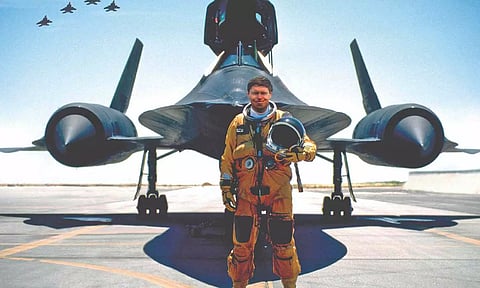

NEW YORK: Brian Shul, a retired Air Force major who modestly described himself as “a survivor” rather than a hero, after he was downed in a Vietnamese jungle, where he nearly died before rebounding to pilot the world’s fastest spy plane, died on May 20 in Reno, Nev. He was 75.
Major Shul flew 212 combat missions during the Vietnam War before his T-28 Trojan ground attack plane was struck by smallarms fire and crash-landed near the Cambodian border in 1974, as the war was nearing its end. He underwent 15 operations and spent well over a year as “119 pounds of blood and gauze,” as once put, recuperating from burns that covered half his body and that left his hands and face disfigured. But two days after being released from the hospital, despite doctors telling him that he would never walk again, Major Shul was back in an Air Force cockpit. His final assignment, before he retired in 1990 after a two-decade military career, was piloting the SR-71, the world’s highest-flying jet. The aircraft, nicknamed the Blackbird and deployed to monitor Soviet nuclear submarines and missile sites, as well as to undertake reconnaissance missions over Libya, could soar to 85,000 feet, fly at more than three times the speed of sound and survey 100,000 square miles of the Earth’s surface in a single hour.
“To fly this jet, and fly it well, meant establishing a personal relationship with a fusion of titanium, fuel, stick and throttles,” Major Shul wrote in his book “Sled Driver: Flying the World’s Fastest Jet” (1991), invoking the detractive nickname that U-2 pilots had pinned on their faster Blackbird counterparts. “It meant feeling the airplane came alive and had a personality all her own.”
Major Shul piloted the Blackbird for 2,000 hours over four years. He was armed with a personal camera that he used to capture the photographs that illustrate “Sled Driver” and another book. The Lockheed Martin SR71 soared so high into the mid-stratosphere that its crew was outfitted in spacesuits, and it flew so swiftly that it could outpace missiles.
“We were the fastest guys on the block and loved reminding our fellow aviators of this fact,” Major Shul wrote.
He often recalled a radio exchange with air traffic controllers monitoring the ground speed of planes within their jurisdiction as his aircraft screamed 13 miles above Southern California: “I heard a Cessna ask for a readout of its ground speed. ‘90 knots,’ Center replied. Moments later, a Twin Beech required the same. ‘120 knots,’ Center answered.
“We weren’t the only ones proud of our ground speed that day,” Major Shul recalled, “as almost instantly an F-18 transmitted, ‘Ah, Center, Dusty 52 requests ground speed readout.’ There was a slight pause, then the response, ‘620 knots on the ground, Dusty.’” Major Shul and his crew member couldn’t resist asking, too: “‘Center, Aspen 20, you got a ground speed readout for us?’ There was a longer than normal pause ‘Aspen, I show 1,942 knots’” — or 2,234 m.p.h. “No further inquiries were heard on that frequency,” Major Shul wrote.